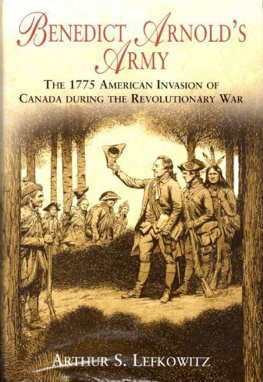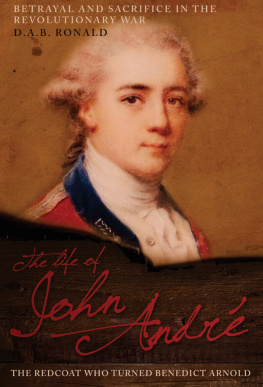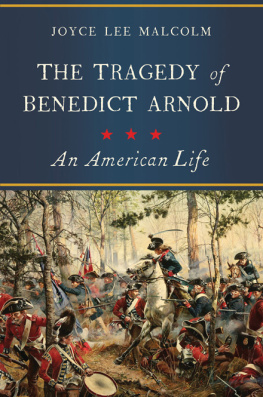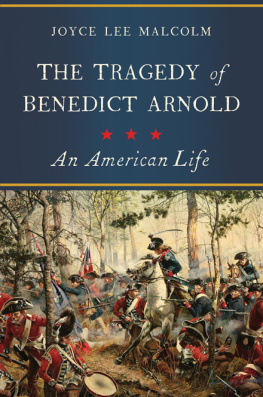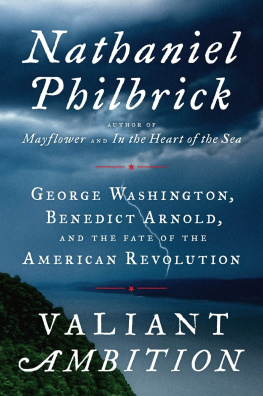Also by Arthur S. Lefkowitz
The Long Retreat: The Calamitous American Defenseof New Jersey 1776
George Washingtons Indispensable Men: The 32 Aides-de-Camp Who Helped Win American Independence
Bushnells Submarine: The Best Kept Secret of the American Revolution
2008, 2014 by Arthur S. Lefkowitz
Benedict Arnolds Army: The 1775 American Invasion of Canada During the Revolutionary War
All rights reserved. No part of this work may be reproduced, stored in a retrieval system, or transmitted, in any form or by any means, electronic, mechanical, photocopying, recording, or otherwise, without the prior written permission of the publisher. Printed in the United States of America.
Cataloging-in-Publication Data is available from the Library of Congress.
ISBN 13: 978-1-61121-003-3
10 9 8 7 6 5 4 3 2 1
First digital edition

Published by
Savas Beatie LLC
989 Governor Drive, Suite 102
El Dorado Hills, CA 95762
Editorial Offices:
Savas Beatie LLC
P.O. Box 4527
El Dorado Hills, CA 95762
Phone: 916-941-6896
(E-mail)
Savas Beatie titles are available at special discounts for bulk purchases in the United States by corporations, institutions, and other organizations. For more details, please contact Special Sales, P.O. Box 4527, El Dorado Hills, CA 95762. You may also e-mail us at sales@savasbeatie.com, or click over for a visit to our website at www.savasbeatie.com for additional information.
This book is dedicated to my friend
George C. Woodbridge (1930-2004)
Best known as an illustrator for MAD Magazine, George Woodbridge was also an expert on American military history. He combined his talent as an artist with his knowledge of history to create marvelous pictures of American soldiers that were unrivaled for their accuracy. George completed the illustrations for this book shortly before he died. They are a better testimonial to his gift for depicting history than any words can express.
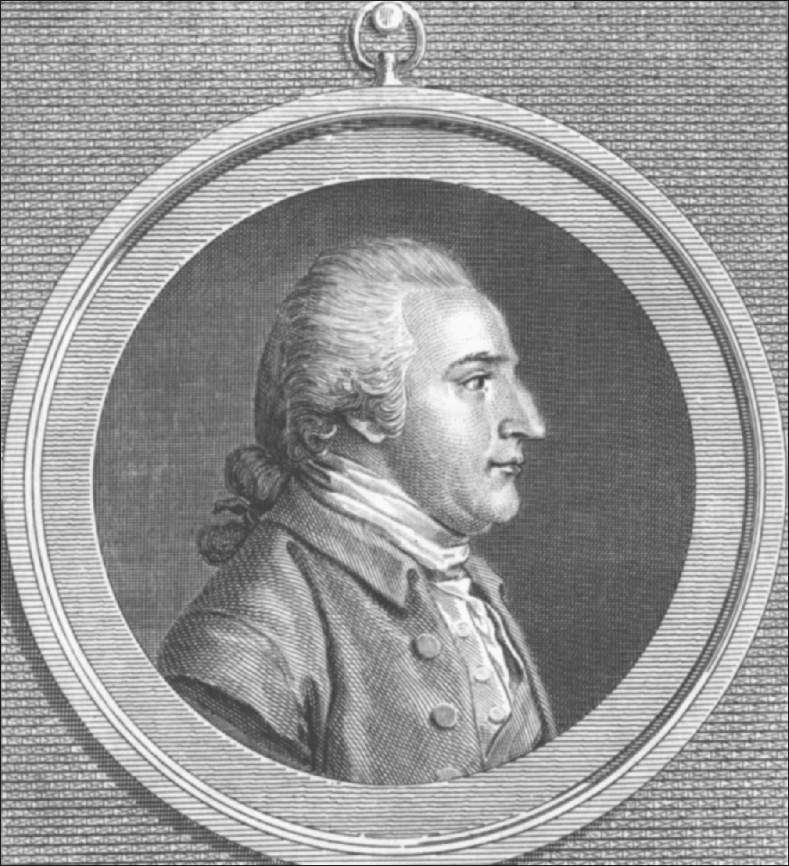
Portrait of Benedict Arnold by Pierre-Eugene Du Simitiere. Executed in Philadelphia in 1779, it is the only known portrait of Arnold believed to be drawn from life.
Authors Collection
Contents
Illustrations
A selection of photos and illustrations have been distributed throughout this book for the convenience of the reader.
Maps
T he courage of the men and women who participated in the 1775 Arnold Expedition makes it one of the most inspiring episodes in American history. The event has interested me since childhood and I am thrilled to have had the chance to research the campaign and traverse its route across Maine and Canada. I believe that many diaries were kept during the campaign, with unusual diligence, because the people on the expedition realized that they were participating in a great historical event and wanted to record their experiences.
Besides working with a fascinating story and excellent contemporary source material, I enjoyed writing this book because it deals with the opening months of the American Revolution. This was an innocent period in our War for Independence, uncomplicated by the problems that would later plague the patriots. At the start of the Revolution, for example, the colonists were able to raise a large army of volunteers while printing presses cranked out millions of dollars in paper money to pay for the war.
During my research, I discovered a long out of print book about the campaign called Arnolds Expedition to Quebec by John Codman, II. This obscure book, published over 100 years ago, turned-out to be the only complete history of the Arnold Expedition. I found it weak in its research but strong in its prose. Codman did such a masterful job of capturing the spirit of the event that I used relevant passages from his narrative for the chapter titles in my book.
I hope my history of the Arnold Expedition adds to our knowledge of the past, and especially of the courageous American patriots who pushed themselves to the limits of their endurance in a bid to snatch the strategic city of Quebec from the British.
I once asked my friend George Woodbridge to define the word historian for me. George said that a historian is anyone who makes their living from history. Applying this formula I am pleased to acknowledge the historians who helped me craft this book. They are economic historian John J. McCusker (Trinity College), the distinguished author Thomas Fleming; Philander D. Chase, Senior Editor of the Papers of George Washington; Arthur Spiess and Leon E. Cranmer, Historical Archaeologists with the Maine Historic Preservation Commission; Patricia Kennedy from Parks Canada; Andr Charbonneau, Ph.D. from the Quebec Service Center of Parks Canada who expertise is the military history of Quebec; Thomas L. Nesbitt, Park-Recreation Supervisor at Crown Point State Historic Site, New York whose special interest are bateaux; Christopher Fox, curator of the Fort Ticonderoga Museum; Eric Schnitzer, the National Parks historian at Saratoga National Historic Site, New York, economics historian Robert E. Wright, Ph.D., and Henry M. Cooke, historical costumer, researcher, and writer whose outstanding work includes the reproductions of George Washingtons uniforms on display at the new Mount Vernon Visitors Center.
Among the other professionals who shared their special knowledge with me were Joseph Rubinfine, an antiques dealer and authority on early American manuscripts; Forrest R. Bonney, a Regional Fisheries Biologist with the Maine Department of Inland Fisheries and Wildlife and Lewis Flagg, Deputy Commissioner of the Maine Department of Marine Resources.
I am also pleased to also acknowledge the help of a number of my fellow enthusiasts who enjoy studying history but earn their living doing something else. Topping this impressive list is Duluth (Dude) E. Wing, a retired Maine Forest Service Ranger who is an expert on the route of the Arnold Expedition. Dude grew up in the heart of Arnold Expedition country and it was my great privilege to have him as my guide through the Dead River, Chain of Ponds, Height of Land and Lake Magentic sections of Arnolds route. Talking to Dude about the Arnold Expedition over breakfast at the Maine Line Caf in Stratton, Maine, was one of the highlights of this project.
I especially enjoyed listening to Dudes stories about the Maine wilderness. One of my favorites is how he told about going into the forest near his home with his father to hunt and fish. Dude said they would often sleep in the woods at night rather than walk back home. In the Maine woods, theres nothing that will hurt you, Dudes father told him. Bears usually vanish, poisonous snakes are nonexistent, and there is no poison ivy. So lay down at dark and enjoy the pine spills or fir bough bed, drink pure mountain water from the books, and feel sorry for all those people who live in the cities and have many things to fear.
The other enthusiasts who helped me were the late George C. Woodbridge, illustrator and authority on the organization, uniforms and weapons of the armies of the American Revolution; John Rees whose interest is 18th Century foods and cooking; Raymond J. Andrews, an architect and expert on the uniforms of the American Revolution; Lt. Gen. David Richard Palmer (retired), the former superintendent of West Point and the author of several military history books my favorite being

